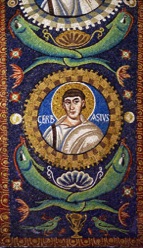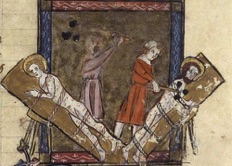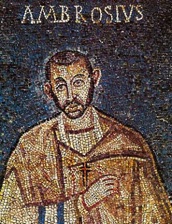Was Gervais de Rait named after a Saint?
Thursday 22 September 2022
Are we of Norman origin after all? I have read recently that William the Conqueror, who died in 1087, was buried at the priory of St. Gervais on a hill in the western suburbs of Rouen, Normandy. A little further research reveals that the priory dates from the 11th century and was demolished and rebuilt over the ensuing centuries - the last time in 1868-1874 in the Romanesque Revival style and the church today is still called Saint-Gervais de Rouen.
So who was St Gervais? Apparently, Gervais and his twin brother Protais were born in Milan, Italy and were martyred there in the mid-2nd century. In Latin their names were Gervasius and Protasius - and variations include Gervase and Protase and Gervasis and Prothasis (Gervais and Protais are the French versions). Their parents were St Vitalis of Milan and St Valeria, both of whom were also martyred - the father in Ravenna, possibly under Nero, and the mother in Milan. Gervais and Protais are the patron saints of Milan, of haymakers and are invoked in the discovery of thieves. Their feast day in the Latin Catholic Church is 19 June, though in the Eastern Orthodox Church the date is either 14 or 24 October depending on when countries adopted the Gregorian calendar. In Christian iconography their emblems are the scourge, the club and the sword.
According to Wikipedia, the twin brothers were said to have large hands and had been imprisoned, scourged and then beheaded, during the reign of the Nero. A later Saint, Ambrose (Ambrosius), had built a magnificent basilica in Milan in 838. Asked by the people to consecrate it in the same solemn manner as was done in Rome, he promised to do so if he could obtain the necessary relics of the two brothers. In a dream, he was shown the place where such relics could be found. He ordered excavations to be made outside the city in the cemetery of the Church of Saints Nabor and Felix, who were at the time the primary patrons of Milan, and there were found the relics of Saints Gervasius and Protasius.
Immediately after the discovery of the relics by Saint Ambrose, the cult of Saints Gervasius and Protasius spread throughout Italy and churches were built in their honour at various places in the country. In Gaul (modern-day France), around the year 400 churches were also dedicated to them, including at Rouen. At the Louvre in Paris, there hangs a famous picture of the saints by Lesueur (d. 1655), which was formerly in their church, Saint-Gervais-Saint-Protais in Paris.
A recent forensic examination of the brothers' relics confirmed several of the traditional details of the story: that they were young, in their mid-20s, definitely brothers, and most likely twins, since they suffered from the same congenital defect of the vertebrae, and had very similar faces. One of them was decapitated, and had signs of injury on the ankle, the other was wounded on the hand with a small weapon of some sort.
Quite why the priory in Rouen, which was attached to the Benedictine Abbey of Fécamp, adhered to St Gervais is not known, but it is tempting to think that an ancestor of our Sir Gervais de Rait (d c 1297), Knight and Constable of Invernairn Castle, Nairn, Moray, perhaps either came from this neck of the woods or else venerated this particular saint. Perhaps an ancestor, with the name running in the family, accompanied William on his regime change in England or perhaps Gervais was born on 19 June and named after the saint.
**********
However, there are several other Gervases in history, who may have been named for the saint (or perhaps our man was named after one of them!) However, none of these appear to be present in Scotland. For instance: Gervase of Besançon (died 685), saint and a bishop of Besançon; Gervase of Bazoches (died 1108), Prince of Galilee; Gervase of Blois (died c. 1157), Abbot of Westminster in England; Gervase de Cornhill (c. 1110–c. 1183), Anglo-Norman royal official and sheriff; Gervase of Chichester (died c. 1197), English clergyman and writer, clerk to Henry II and Thomas Becket; Gervase of Canterbury (c. 1141–c. 1210), English chronicler; Gervase of Tilbury (c. 1150–c. 1228), English chronicler; Gervase of Ebstorf, author of the Ebstorf Map created c. 1234 - possibly the same man as Gervase of Tilbury; and Gervase Alard (1270–1340), Admiral of the Cinque Ports Fleet and Admiral of the Western Fleet of the English Navy.
The Ebstorf Map was an example of a mappa mundi (a Medieval European map of the world). It was made by Gervase of Ebstorf some time between 1234 and 1240. But the date is controversial and could be as early as 1208 or as late as 1300. According to Wikipedia in the case of the earlier date, Gervase of Tilbury is regarded as spiritus rector of the map and the author of the Otia imperialia, an encyclopaedic description of the world which he dedicated to the Holy Roman Emperor Otto IV of Brunswick. This Gervase is perhaps identical with Gervase, provost of the convent of Ebstorf south of Lüneburg (1223–1234, died before 1244). If the Ebstorf map really was made around 1300, then it could be seen as a copy of Gervase of Tilbury's earlier map.
Gervase of Tilbury (c. 1150–1220) was an English canon lawyer, statesman and cleric, born in West Tilbury in Essex, the son of a knight of the Honour of Rayleigh. He enjoyed the favour of Henry II of England and later of Henry's grandson, Emperor Otto IV, for whom he wrote his best known work, the Otia Imperialia. Gervase travelled widely, studied and taught canon law at Bologna, was in Venice in 1177, at the reconciliation of Pope Alexander III and Frederick Barbarossa, and spent some time in the service of Henry II of England, and of his son, "Henry the Young King". For the latter he composed a Liber facetiarum (‘Book of entertainment’), now lost, as well as the basis for what would become the Otia Imperialia. He also served William of the White Hands, the brother of the Count of Blois William of Champagne, Archbishop of Reims. Some time after 1183 Gervase found service at the court of William II, the Norman king of Sicily, who had married Henry's daughter Joan. From William he received the gift of a villa at Nola in Campania. After the King of Sicily's death in 1189, Gervase moved to Arles and became a judge of canon law. In 1198, Otto appointed Gervase Marshal of the imperial court in the Kingdom of Burgundy-Arles (1209-1214). Gervase married into a local family and accompanied Otto to Rome in 1209 on the occasion of his Imperial coronation.
Then there is Gervase of Canterbury (c. 1141 – c. 1210) - an English chronicler. If Gervase's brother Thomas, who like himself was a monk of Christ Church, Canterbury, was Thomas of Maidstone, then they came from a Kentish family. Records show that Gervase took a prominent part in the disputes between the monks and Archbishop Baldwin (1185-1191) and was one of the monks sent to announce to the archbishop an appeal to the pope. In 1189 he was one of a deputation sent to lay the matter before King Richard I. Gervase, as a senior monk, was made sacristan and in 1193 attended the new Archbishop, Hubert Walter, in that capacity. This Gervase has occasionally been confused with others of the same name, notably with Gervase of S. Ceneri, and thus he is described as prior of Dover, though this is impossible on chronological grounds. He has been identified with Gervase of Chichester, and also with Gervase of Melkley, who was born about 1185 in England and who was a Norman scholar and poet. Around 1200, he studied in France, probably in Rouen, under poet John of Hauville, though he spent his adult life in England. He was mentioned as an astrologer and an authority for the life of Stephen Langton, Archbishop of Canterbury, and described as the author of the epitaph on William Marshal, 1st Earl of Pembroke, who died in 1219.
Gervase of Chichester (died c. 1197) was an English clergyman and writer active in the late 12th century. He was a pupil or student of Hilary of Chichester, the Bishop of Chichester. Around 1158 Gervase appears as a clerk to King Henry II of England, while also simultaneously serving Henry's chancellor, Thomas Becket. The king and Becket arranged for Gervase's appointment to two churches – Basing and Shelbourne in Berkshire. Gervase followed Becket to Canterbury when Becket became Archbishop there, however, he did not follow Becket when the Archbishop went into exile in 1164, but instead returned to Chichester and the service of Hilary.
Next we have Gervase de Cornhill (c. 1110 – c. 1183) who was an Anglo-Norman royal official and sheriff. Beginning his royal service as a justice in London in 1147, he continued to serve both King Stephen of England and Henry II until his death around 1183. Gervase was said to be the son of Roger, nephew of Hubert the Queen's Chamberlain.. However, other scholars argue that Gervase was Hubert's nephew. He married Agnes, the daughter of Edward of Cornhill and after his marriage, he became known as de Cornhill because of his wife's property. He was Royal Justice in London from 1147 and continued to claim that title through the 1170s on his personal seal. He was one of the members of the royal administration under King Stephen of England and was also a merchant and financier. Around 1143 he loaned money to Stephen's wife Matilda of Boulogne, and received in pledge land at Gamlingay in Cambridgeshire. The queen was unable to repay the debt, and the lands pledged eventually became Gervase's. Gervase also loaned money to Hugh Tirel, son of Walter Tirel, in 1146 to enable Hugh to go on the Second Crusade. In return, Hugh pledged the manor of Langham in Essex to him. Gervase held the office of Sheriff of London from 1155-1157, again from 1160-1161 and possibly from 1159-1160. He also held the office of Sheriff of Surrey from 1163 until his death as well as the office of Sheriff of Kent from 1167-1174. Gervase was named a judge on one of the eyre (itinerant) circuits in 1170.



